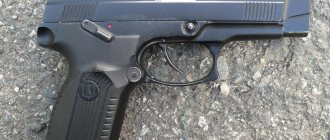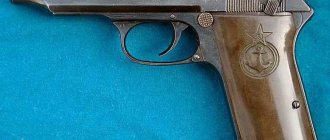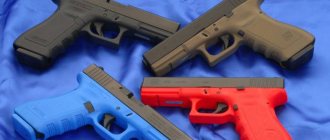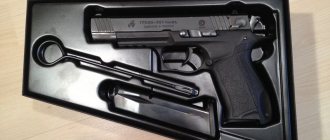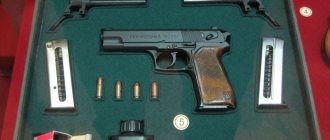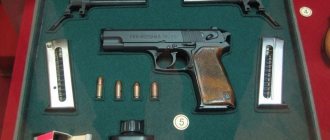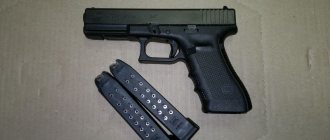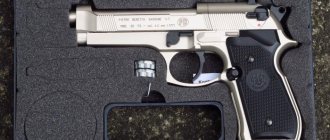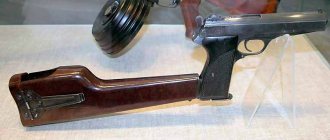What it is?
In the early 1980s, the Union created a special pistol for self-defense of astronauts. The weapon had three barrels and was based on a non-automatic design. The new pistol was called TP-82. It became part of the SONAZ rescue complex. In appearance, the weapon looks a lot like a hybrid of a double-barreled shotgun with an AK: on top there are two smooth 32-caliber (hunting) barrels, and below there is a 5.45-caliber barrel.
Prerequisites for the occurrence
The creation of such a weapon was first proposed by the legendary Soviet cosmonaut Alexei Leonov. In 1979, he visited the Tula Arms Plant specifically for this purpose. He told the gunsmiths about an incident that occurred in 1965: then the descent module of the Voskhod-2 spacecraft landed in an unplanned place. More precisely, in the deep forests of the Perm region. They searched for the astronauts for almost two days, during which people had a hard time.
In those forests there are many predators who would obviously not mind tasting fresh astronauts. The situation was absurd in that the latter would have absolutely nothing to defend themselves with in the event of an attack. Leonov noted that if the cosmonauts had at least some specialized weapons with which they could fight off the animals, they would feel much calmer. Already in 1981, the position of the man who was the first to go into outer space found wide official support. In 1982, TP-82 was officially included in the rescue kit of all space missions.
Development
Leonov's idea, which had great influence as the first man to walk in outer space and as deputy head of the Cosmonaut Training Center, quickly received official support. In October 1979, the technical specifications for a survival pistol were ready, and gunsmiths from Tula proactively began developing design solutions to fulfill this task.
Initially, development was carried out in three directions: a smoothbore gun, a revolver and a three-barreled pistol. The idea of a gun was abandoned immediately, since due to its large dimensions and weight it simply did not fit into the trigger device. The expert commission also did not like the revolver with cameras of different calibers. The three-barrel pistol was approved and recommended for improvement. From that moment on, all the forces of the gunsmiths were directed towards him.
The main purpose of the weapon
It should be noted that this pistol is not only a space pistol.
It is intended, among other things, to arm long-range aviation crews who could find themselves in wild territory as a result of an unplanned emergency landing. The TP-82 model can be used for defense against predators, unfriendly people, criminal elements, and also for hunting. Using the same pistol, it is possible to send light and sound distress signals in the event of landing in a sparsely populated, empty area. Weapons were created in Tula. The pistol first went into space with the crew of the Soyuz T-6 spacecraft in 1982. Four years later, it officially began to be included in the equipment of long-range aviation crews. The release was completed in 1987. There is information that the TP-82 pistol was used by Russian cosmonauts until 2007. By the end of this period, the storage life of the ammunition that was manufactured in the Union had simply expired. It was considered inappropriate to resume their production.
Cosmonaut survival weapon: TP-82 pistol
In the 1980s, the USSR created a weapon for self-defense of cosmonauts - a hunting non-automatic 3-barreled pistol TP-82, which was part of the special SONAZ (carryable emergency small arms) complex. The initiator of the creation of special small arms for domestic cosmonauts was Alexey Leonov. The famous Soviet cosmonaut in 1979 visited a weapons factory located in Tula. There he told the weapons designers that the cosmonauts from the Voskhod-2 spacecraft who landed in the Perm region in 1965 lost contact with the search group. As a result, the astronauts were forced to wait for help all day. They searched for the astronauts using helicopters. All this time that they spent in the winter forest in deep snow could be their last. The Permian forests are home to a large number of different predatory animals that could attack people. At the same time, the astronauts had absolutely nothing to protect themselves with. Then Leonov noted that if the cosmonauts had a special multifunctional weapon, they could feel more confident in the winter forest. In 1981, the idea of Leonov, who at that time was not just the first cosmonaut to go into outer space, but also the deputy head of the Cosmonaut Training Center, quickly found official support. Already in 1982, the TP-82 pistol was officially accepted to supply Soviet space missions.
TP-82 was designed to ensure the survival of cosmonauts and crews of long-range aviation aircraft that landed outside a given territory, in wild natural conditions. TP-82 is a non-automatic three-barrel hunting pistol. Its main purpose is to protect astronauts from dangerous forest animals, as well as criminal elements; the weapon can be used to obtain food by hunting, as well as to provide visual observation light signals if the descent vehicle has landed or splashed down in a sparsely populated, uninhabited area. The pistol has 2 horizontal upper smooth barrels of 32 hunting caliber and a 5.45 mm rifled barrel underneath.
The development of the pistol was carried out by the Tula Arms Plant, and the creation of ammunition for it by the Central Research Institute of Precision Engineering, located in the city of Klimovsk. The first domestic spacecraft to include this pistol complex was the Soyuz T-6, which was launched into space in the summer of 1982. Four years later, the TP-82 pistol was also adopted by the USSR Air Force; it was planned to be used as a survival weapon for long-range aviation pilots who were forced to make an emergency landing. The production of weapons was stopped in 1987. According to information that is publicly available, non-automatic TP-82 pistols were part of the portable emergency reserve of Soviet and then Russian spacecraft until 2007. At this point, the storage period for weapons ammunition that was produced back in the USSR had expired.
The TP-82 cosmonaut survival weapon is a non-automatic pistol. The barrel block of the pistol consists of 3 barrels. The top two are smoothbore, designed for use with 32-caliber hunting cartridges, the bottom is rifled, designed for use with a 5.45x40 mm cartridge. The lower barrel of the pistol has a special adjustment device, which consists of 3 screws (one on the bottom and 2 on the sides) and is intended for zeroing. Smooth pistol barrels have an ordinary extractor, which moves back when the barrel block is tilted under the influence of 2 pins, which are located in front of the top on the walls of the block from the inside. The lower barrel of the TP-82 pistol has a spring ejector, which is activated when a special button is pressed, which is located on the receiver block on the left side, from below.
Reloading the TP-82 pistol is carried out by “breaking” the barrel block (like in hunting rifles); the barrel latch has the shape of a long lever, which is located in a horizontal position on the left above the pistol grip. In order to open the barrel block, you need to press the lever to the left. The pistol is equipped with a trigger mechanism, it is not self-cocking, and has 2 open triggers.
The right trigger of the pistol serves the right “smooth” barrel, the left trigger can freely switch between the lower rifled and left “smooth” barrel, for this there is a vertically moving switch on the left side of the frame. On a number of samples of the TP-82 pistol, an automatic safety was installed, made in the form of a button on the handle located under the trigger guard. The sighting device of the pistol is open type, fixed. In order to increase the accuracy of shooting from the weapon, it was standardly equipped with a removable butt, which was freely attached to the lower part of the pistol grip. This butt was also a specially designed machete with a trapezoidal blade enclosed in a semi-rigid sheath. For firing, the sheathed machete was attached to the TP-82, at which time the lower part of the sheath played the role of the butt plate.
The weapons used cartridges specially created at TsNIITOCHMASH. The head of the work on their creation was P.F. Sazonov. The set of developed ammunition included 3 cartridges. The first of them was a fractional SP-D (created on the basis of a hunting 32 caliber). The 12.5x70mm shotgun cartridge in a brass case was equivalent to the standard 20-gauge (15.9mm) hunting rifle cartridge with No. 3 shot, which was used in hunting rifles with a barrel length of 700 mm. The SP-P signal cartridge was also designed on the basis of a hunting cartridge (signal cartridge with one red “star”). It was significantly superior to the previously used 15-mm 7S8 cartridge, primarily in terms of the signal block’s burning time. The bullet cartridge was designated SP-P. It consisted of a 5.45x40 mm semi-jacketed bullet with a steel core and a special hole in the nose to increase the expansive action. The extent of destruction with such a cartridge was 8-10 times greater than that of a bullet from a 5.45 mm caliber 7N6 machine gun cartridge.
The effective firing range of these cartridges from the TP-82 pistol reached 200 meters when using SP-P and up to 40 meters when using shot. The standard ammunition of the weapon included 31 rounds: 10 rounds of SP-D and SP-S, as well as 11 rounds of SP-P, which were placed in a special canvas pouch. In the design of all these ammunition, measures were implemented to ensure operability and maintain their tightness even after a relatively long stay in a low-pressure vacuum.
The pistol was actively tested as a hunting tool. With the help of smooth trunks it was possible to catch small animals, such as a hare or a fox, as well as a huge number of birds - from partridges to black grouse and wood grouse. With the help of a rifled barrel it was possible to shoot wild boars, mountain goats, saigas, goitered gazelles, and small elk with an animal weight of up to 200 kg. At the same time, the SP-S signal cartridge turned out to be the most effective means of signaling in terms of visual observation parameters at that time (when compared with all existing means).
Of course, when landing in the taiga, the TP-82 pistol would be a significant help for astronauts. The removable butt of the pistol, which also served as a machete, did its job perfectly. According to the head of cosmonaut training, Alexander German, there were cases when a number of cosmonauts, in two days of survival (this is the duration of training in a winter forest), cut down several cubic meters of forest to provide themselves with firewood and build shelters.
The TP-82 pistol gave the impression of a durable, reliable and well-made product. Its elements such as a holster, a machete case, and a bandoleer had minimal weight. The controls were convenient, the manipulations carried out with them were logical and simple. The safety devices on the pistol ensured safe handling of the weapon, including when the weapon was dropped or when the barrel block was not completely locked. Experts noted the soft descent, good balance of the model and a “gripty” handle. It could be fired with or without a machete stock attached. Without attaching a stock, it was best to fire with shot at point-blank range or with signal cartridges.
The TP-82 pistol was put into service in 1986 and flew into space for the first time in the same year. They were armed with Soviet cosmonauts from the joint Soviet-French crew. Its production was discontinued in the late 1980s. Officially, for the reason that there were enough manufactured pistols, and their further production was impractical. However, according to Tula gunsmiths, the lack of funding was to blame. In total, during the production in Tula, according to various sources, they managed to assemble from 30 to 100 “space” pistols. Currently, everyone can see rare weapons in the Artillery Museum of St. Petersburg, the State Arms Museum of Tula and as part of the exposition of the Memorial Museum of Cosmonautics in the Russian capital.
Tactical and technical characteristics of TP-82: Caliber: 2x12.5 + 1x5.45 mm. Length - 360 mm, with butt - 670 mm. Barrel length - 300 mm. Height - 150 mm, with butt - 235 mm. Curb weight - 1.6 kg. Weight including machete butt - 2.4 kg.
Sources of information: https://world.guns.ru/shotgun/rus/tp-2-r.html https://www.popmech.ru/blogs/post/5071-evolyutsiya-oruzhiya-tp-82-oruzhie- kosmonavta https://www.worldweapon.info/tp-82 https://ru.wikipedia.org/wiki/%D2%CF-82
Main technical characteristics
As we said, this weapon is a three-barreled non-automatic pistol. The two upper barrels are designed for a more or less conventional 32 caliber, while the lower one is loaded with a special 5.45x40 mm cartridge. Let us remind you that Kalashnikov assault rifles use 5.45x39 mm ammunition. To zero the lower barrel, a special zeroing device is used, the strength of which is adjusted by three bolts.
The evacuation of spent cartridges from 32 caliber occurs using an ordinary extractor. To eject a spent cartridge case of a 5.45x39 cartridge, you need to press a special spring extractor button, which is located at the bottom of the weapon. Thus, the TP-82 pistol is quite simple, and therefore the cosmonauts, who were mostly military pilots, did not have any problems when handling it.
To reload, the weapon must be broken, like a hunting rifle. On the left above the pistol grip there is a latch that holds the entire structure. To break the TP-82 space pistol, it is moved to the left. The trigger mechanism is of the hammer type and does not have self-cocking. In general, its design is extremely simple, but there are some important features.
Trunks
The barrel block of this pistol includes three barrels. The top two are smooth, designed for a 32 caliber hunting cartridge, the third bottom is rifled, designed for a 5.45 mm caliber cartridge. The lower barrel is equipped with an adjustment device consisting of 3 screws. Two of them are located on the sides, and another one is located below. Screws are designed for zeroing weapons.
The upper smooth barrels are equipped with an ordinary extractor, which, when the barrel block is tilted, moves back due to a pair of pins located on the inner walls of the block. The rifled barrel of the TP-82 cosmonaut weapon also has a spring ejector, which is activated by a special button located on the lower left side of the barrel block.
Reloading a weapon is done by breaking the barrel block, similar to how a similar operation is carried out with classic hunting rifles. The barrel latch is made in the form of a long lever, which has a horizontal position and is located above the pistol grip on the left. To open the barrel block, you need to press the lever to the left.
Triggers and sights
The peculiarity of the trigger mechanism is that the right trigger is responsible only for the right smooth barrel, while the left one can be switched between the left and lower barrels at any time. Under the trigger guard there is a safety button that locks the triggers. The TP-82 space pistol has the simplest sighting device: mechanical, open type. This is done to minimize the likelihood of shooting down even in the most difficult conditions.
Taking advantage of Tokarev’s experience, experts provided for the use of a butt-holster. This simple device can significantly improve shooting accuracy. The holster is attached to the bottom of the pistol grip. But this is not the main secret. The fact is that inside the holster, in a special hard sheath, there was... a real machete, only a relatively small one. Moreover, it was recommended to shoot precisely when it was inside the holster, since in this case the butt received the necessary rigidity. In short, the TP-82 cosmonaut pistol is a very unusual and extremely versatile weapon.
The present and future of astronaut weapons
At the Tula Arms Plant, after agreeing in October 1979 on the terms of reference for the development of weapons for astronauts, as part of the research work they began to develop the TP-82. And already at the end of 1980, the prototype was submitted by the astronaut for approval. Subsequently, in 1983, TOZ and another enterprise that developed cartridges for these weapons presented a complex of small arms with cartridges for the cosmonaut’s portable emergency reserve “Sonaz”. At the same time, production of this model was launched on the TOZ basis, which continued until the early 90s. last century. We produced several dozen Sonaz kits. In accordance with the instructions for the operation of these weapons: at the next launch of the cosmonauts into orbit, the crew commander received the weapon along with ammunition against receipt - 40 rounds of ammunition and 10 signal flares; after returning from orbit, the crew commander handed over the weapon and ammunition to the warehouse.
At the end of the last century, TOZ specialists conducted marketing research on the market for weapons of this class and found that they are in demand by specialists whose civilian professional activities involve working in hard-to-reach places and in places with harsh climates - these are geologists, pilots, travelers, tourists and residents northern territories of the country.
The market for this weapon is potentially very large and it can find its consumer. And to solve this problem, it is desirable to restore the production of the Sonaz complex. But so far, financial and legal obstacles have hampered a positive solution to this issue.
Currently, one copy of the TP-82 cosmonaut weapon is stored in the funds of the Federal State Institution "TGMO" and in the Cosmonaut Training Center.
Characteristics of cartridges
Its special feature is that for firing it was supposed to use cartridges specially developed at TsNIITOCHMASH.
P. F. Sazonov supervised the creation of new and unusual ammunition. A total of three types of cartridges were developed. The first is a standard SP-D shotgun, created using a regular hunting 32 caliber. The 12.5x70 mm cartridge is completely similar in its lethal effect to ammunition that is used in hunting rifles with a barrel length of about 700 mm. The second variety, SP-P, is a signal one. A simple hunting cartridge was also used as its base. Actually, in terms of its design, it is a special light-smoke bomb with a long burning time.
Finally, the SP-P bullet cartridge. It is equipped with a 5.45 mm semi-jacketed bullet, compressed into a 40 mm sleeve. The core was made of hardened tool steel; to increase the expansive action, a small hole was drilled in the nose of the bullet. According to test results, wounds from such ammunition were several times more dangerous than from a standard machine gun cartridge.
Machete
Definitely, if the spacecraft were to crash land again in the taiga, the crew armed with survival pistols would become almost invulnerable. The removable stock, which can also be used as a machete, coped well with the assigned tasks. According to the head trainer of the cosmonauts, Alexander German, during two-day training trips into the winter forest, the crew of one ship used a machete to cut down several cubic meters of vegetation, which was used to build shelters and maintain a fire.
About the effective firing range
It was reported that when using a bullet cartridge, the effective firing range could reach about 200 meters, but in the case of using shot, this value was reduced to 40 meters. The ammunition included exactly 40 rounds of ammunition: ten each SP-D and SP-S. All the rest are bullets. The ammunition fit in a special canvas pouch. The main difference between all these cartridges and their military and hunting prototypes was their maximum reliability, which was maintained even in conditions of low pressure, high and low temperatures, and humidity.
Hunting use
Throughout the entire period of state testing, the TP-82 pistol, a photo of which you can see in the article, was intensively used as a hunting weapon. It was found that with its help, without much difficulty, you can catch almost all categories of small game, as well as birds, for which the TP has proven itself especially good at shooting. A rifled barrel could be used to hunt wild boars, goats, goitered gazelles and even elk, provided that the weight of the animal reached no more than 200 kilograms.
The testers were so impressed by the weapon’s capabilities that the latter received the apt nickname “a poacher’s dream.” It was reported (unofficially) that when using ordinary 32-caliber hunting cartridges with an increased weight of gunpowder and large shot, it was possible to kill an elk weighing significantly more than two hundredweight without much difficulty.
Exploitation
In 1982, a three-barreled pistol from the Tula plant went into space for the first time. They armed the Soviet cosmonauts who were part of the Soviet-French crew. However, the weapon was officially adopted only in 1986. The general public first saw the “space gun” at the “Road to the Stars” exhibition, which was dedicated to the 25th anniversary of Gagarin’s flight into space.
At the end of the 1990s, production of SONAZ TP-82 was discontinued. The official reason for the closure of production was the fact that a sufficient number of pistols of this model had been produced, and their further production was not advisable. However, according to Tula gunsmiths, the main reason was insufficient funding for the project. According to various sources, during the production of the TP-82 pistol, the description of which is coming to an end, from 30 to 100 copies rolled off the assembly line.
Today, anyone can see this model of weapon. To do this, you need to visit the Artillery Museum of St. Petersburg, the Tula Arms Museum or the Memorial Museum of Cosmonautics in Moscow. In addition to the pistol itself, museum exhibitions also include a set of additional equipment for the TP-82. The price of admission to the museums listed above is very affordable.
Overall efficiency of use
The signal cartridge turned out to be very good. The sound and noise flash that occurred when it was used gave a significant chance that search teams would be able to notice people. In short, the TP-82 is a weapon that could be an excellent help for astronauts who find themselves in the remote taiga. Even the machete, which was “hidden” in a holster, proved to be excellent.
Alexander German, who served as head of cosmonaut survival training, said that in two days (the standard duration of training), his students used this blade to cut down several cubic meters of wood. So a machete could be useful even when building a temporary house!
What general impression does the TP-82 make? The astronaut's weapon looks very good and solid, it is made with high quality. All accessories such as the holster, pouch and machete are kept at the lowest possible weight. The weapon controls are made according to ergonomic designs; even a person with minimal training can operate them easily and simply. Fuses ensure complete safety of handling even with a loaded weapon, completely eliminating the possibility of an accidental shot. Gunsmiths really liked the soft trigger, the grip of the handle and the precise balance of the pistol.
There is no strict need to attach a butt for firing, so if necessary, one could begin defense immediately without spending extra time on preparation. It was reported that without a holster it was advisable to fire exclusively with shot at short distances.
Requirements for an astronaut's weapon
In accordance with the technical specifications, the crews of space and aircraft were to be armed with small-sized functional weapons. It was intended for hunting, protection from predators, self-defense and providing light signals in case of landing or emergency landing in a deserted area. The sample was supposed to provide: - a comprehensive solution to the problems of survival of the crew of a vehicle in distress; - use as both a firearm and a cutting tool; — the ability to perform all operations with one hand; — selectivity of a shot with any type of ammunition (the range of ammunition used included shot, bullet and signal cartridges); — if necessary, perform shooting and cutting operations independently of each other; — the weapon must have a detachable butt; — transportation of weapons and detachable butt; - should be carried out in a holster, cartridges in separate cartridge belts; — the sample was required to be equipped with a waist and shoulder belt; — in the stowed position, the weapon and its components must be securely attached to the astronaut’s spacesuit or pilot’s flight suit; — it was necessary to ensure a firing range of at least 40 m for a shot cartridge, at least 200 m for a bullet cartridge, and a burning time of a signal block of at least 8 s; — the weight of the weapon with components is no more than 2.0 kg; — incomplete development/assembly should be carried out without the use of special tools.
Discontinuation
The TP-82 three-barrel cosmonaut pistol was finally put into service in 1986. Soviet cosmonauts were always armed with it, including during joint training and missions with the Americans and Europeans. The production of weapons was discontinued in the late 80s. The official reason is the accumulation of a sufficient number of pistols. The Tula residents themselves say that during the beginning of the collapse of the state, the Kremlin authorities simply did not want to finance the “stupid” project.
The exact number of pistols collected is still unknown. It is assumed that the production volume is unlikely to exceed 30-110 units (which is clearly very small). If you want to see this rare pistol with your own eyes, you can visit the artillery museum in St. Petersburg, the cosmonautics museum, which is located in Moscow, or go to Tula.
Ergonomics
The “Cosmonaut Pistol” gave the impression of a reliable and high-quality product. Additional equipment, namely a holster, a machete case and a bandolier, had minimal weight and maximum functionality.
The pistol had convenient controls that operate simply and logically. When creating weapons, the designers took into account that they would not be used by professional soldiers. Safety devices made it possible to make handling weapons as safe as possible. Experts testing this pistol have repeatedly noted its soft trigger, good balance and comfortable grip. Without a stock, it is convenient to fire with shot or signal shells. For more accurate shooting of bullets, it was recommended to use a butt.
"Boar"
According to not very official information, there was (or exists) an analogue of the TP-82 called “Vepr”. In reality, no one has seen such a pistol; there are no photographs of it. Presumably this ersatz was produced with a less strict quality control system and was intended for long-range aviation commanders. However, all these are just rumors, since there is practically no official data on this weapon. Be that as it may, the Vepr was equipped with the same special cartridges, and therefore in 2007 the life of this weapon (even if it existed) also came to an end.

